Poles -- And the Men Who Love Them
compiled and edited by Carol McDougald
Reprinted from "Crown Jewels of the Wire", January 1997, page 15
For several years I have been accumulating snippets of information sent by
readers about linemen and utility poles. I decided it was time to get an article
assembled.
It may even spark some interest for future articles.
So, here we go...
| A tribute to the lineman
They sing of the men as goes down to the sea,
Of the heroes of cannon and sword
They tell tales of a dead chivalry,
And the bravery of old knights and lords.
They sigh cause the romance of knighthood is past,
That there ain't no ideals anymore.
They say this old world's a rolling too fast,
To develop that Esprit-de-corps.
But them that complain are the ones that don't know,
Who sit loose where
it's warm and then kick.
They ain't never seen a line saggin' with snow,
And had to get service back quick.
They ain't never struggled with death at their side,
A snappin', hissin'
and pale,
Nor clung to the towers and grimly defied
The assault of the
blizzard and gale.
They sit and are served with never a thought,
Of the fellows out
plugging like hell,
To supply at their touch the service they bought,
With a
light or the sound of a bell.
The lineman ain't decked out in armor of steel,
He don't ride around on
no hoss,
They don't write songs about how he must feel,
In a blizzard when
the lines, sometimes cross.
His armor ain't nothin' but belt and boots,
His weapons are climbers
and pliers.
His battles are fought up where high voltage shoots
And death
lurks unseen on the wires.
So here's to the lineman, that son of a gun,
Who can go without sleep
for a week,
Who sticks to the job 'til it's every bit done,
And the lines
can carry their peak
For his is that knighthood that's noblest by far,
That highest and
mightiest clan,
Who is fighting the battles of things as they are,
For one
cause, just service to man.
--Anonymous (sent by Bud Thompson, Boise, ID)
|

Large Image (115 Kb)
A Civil War era (1861-1865) signalman in civilian garb clings to
the top of a telegraph pole,
ready to test or repair the wires. A pocket-size telegraph key was used to
tap wires to intercept messages or to send
false ones.
Photo is shared by Ed Hunt, Apache Junction, Arizona.
|
|
America's Oldest
Transmission Line Relies on
Western Red Cedar Poles
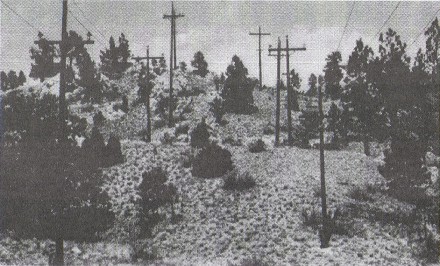
Missouri River Transmission Lines.
Photo courtesy Montana Power Co.
Between 1900 and 1902 two parallel power lines, Missouri River lines A
and B, were installed between the old Canyon Ferry power plant at Helena
and Butte, Montana, a distance of 63 miles. These lines remain in service
from Helena to Boulder and still rely on the original Western Red Cedar
poles.
History
From the headquarters of the Montana Power Company in Butte, Ed
Hildreth, Purchasing Agent, reports that the power originally transmitted
on the Missouri River lines was used for the operation of the Colorado
Smelter just east of the town, and for the mammoth 900 h.p. compressor at
the Anaconda Mine.
According to Hildreth, these were probably the first real transmission
lines in America and possibly the world -- certainly for a time they were
the world's highest powered at 60 KV. At present, the lines are energized
at 69 KV.
1965 Inspection Report
A 1965 inspection report on the A line states that when the
original lines were constructed through the wilderness between Boulder,
Montana, and Butte, a wagon road was cut through the timber and into a
mountainside, necessitating the dynamiting and moving of large quantities
of rock. Where the lines crossed a swampy area at the 7,000 ft. level, a
one-mile long roadway was constructed. Large poles were laid in the swamp,
then small poles acting as stringers were laid across these poles, and
3-inch saplings laid crossways to the stringers to form the roadway's
deck. The roadway is easily discernible today, even though it has rotted
badly and cannot be used.
The report also says that the lines consist of graded single 35-foot
cedar poles spaced in approximately 110-foot spans, with single 3¾"
x 5½" x 10' crossarms supporting two conductors, with a third
conductor on the pole tops. There were two major stubbing programs in
1924-25, and again in 1941 and 1945. The stubs used in 1924-25 were
heavily creosoted, the majority of which were found to be "as sound
as the day they were installed." Between 1928 and 1932, arsenic
treated stubs were used and "the majority of these indicate a
definite need for repair." The report also says that "it should
be noted that many of the original poles still stand un-stubbed," and
"are suitable for many additional years of use."
1988 Inspection Results
A 1988 inspection of one of the lines between Helena and Boulder shows
that of the 1430 original Western Red Cedar poles, 1355 are still in
service, with 779 having been stubbed for continued use. An impressive
record that testifies to the in-service durability and reliability of WRC
poles.
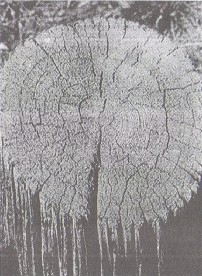
Stump of 87-year-old Western Red Cedar pole in
Missouri River Transmission Line A.
Photo courtesy Montana Power Co.
- - - - - - - - - -
| The Yellow Pine Reigns on the East Coast . .
.
When the pole industry began in the mid-1800's, the Eastern United
States contained unequaled stands of virgin yellow pine -- huge, abundant
forests covering hundreds of millions of acres.
Cross-cut saws were the primary implement used to harvest the majestic
pines.
Lumberman often used oxen to transport heavy logs from one location to
another.
The first pressure creosoting plant in the U.S. was opened in Somerset,
Massachusetts in 1865.
|
Alan says, "In my position, I am responsible for the
procurement of wood poles and routinely receive Cedar Pole News. I
found that occasionally the publication included historical articles
relating to the longevity of cedar for power poles."
"The Helena - Boulder lines in Montana show the use of the
Muncie type insulators (shown on previous page), --- go to page 22.
Alan Drew, Sequim, WA, is General Superintendent for Public
Utility District #1 of Clallum County (Washington), has been researching
the evolution of electric transmission and distribution from a technical
perspective.
|
| Western Red Cedar Poles the Most Durable
-- Naturally
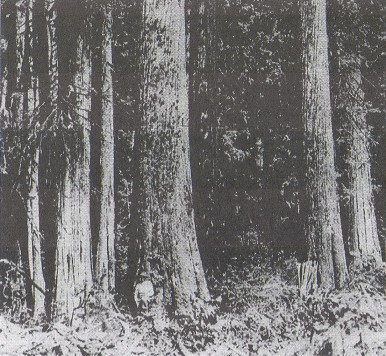
Western Red Cedar (Thuja plicata) is recognized as the most durable
softwood species used for poles because of its many desirable
characteristics. Its most favorable trait is its inherently
decay-resistant heartwood. Fallen cedar trees that have lain for centuries
on the forest floor with very little decay testify to this. So do the many
WRC poles, placed in lines as long as 80 years ago, that are still
providing excellent service.
Resistance to Fungi
Several factors assure the durability of WRC poles, including natural
resistance to fungi. All wood-rotting fungi need food, water, favorable
temperatures, and oxygen if they are to grow. They have different food
needs, but in general, wood provides enough for their development. Usually
wood can decay if the water content is more than 20 percent of its
oven-dry weight, but serious damage occurs only if the moisture content is
greater than 30 percent.
As is true with other growth needs, the optimum temperature for the
various fungi varies considerably. Decay is slow below 32°F and above
100°F. The oxygen requirement is quite low and fungi are able to grow at
levels below the 20 percent oxygen content of air. Control of fungal
activity normally results from depriving the organisms of any one of these
essential elements.
Cedar Extractives
Western Red Cedar has an extraordinary advantage over other species in
that its heartwood contains an unusually high amount of natural substances
called extractives that stop or greatly retard the growth of decay
fungi.
Extractives can be separated into volatile and non-volatile fractions.
The volatile fraction, the thujaplicins, have a fungicidal value very
close to that of pentachlorophenol, so that even if WRC were not treated
with preservatives it would last a very long time. The non-volatile
extractives are a complex mixture of phenolic materials which are much
less toxic to fungi than the thujaplicins.
The extractives in the heartwood of WRC makeup about 10 percent of its
dry-wood weight, which is about twice the amount found in other pole
species. These materials are deposited in the wood cells as the heartwood
forms and the proportion of extractives to dry wood increases as the tree
gets older. By the time WRC trees reach pole size the outer part of the
tree sometimes contains as much as 20 percent extractives. These
extractives stop fungi from developing, providing a built-in advantage for
WRC over an other pole species.
Groundline Treatment
Decay in WRC poles, when set in a line, is almost exclusively a result
of fungus activity at the groundline area or where a "groundline
condition" exists - e.g., butt-ends of poles set in extremely rocky
or porous soils or where water becomes trapped above ground.
Below ground, the lack of air helps to prevent decay. In the
above-ground section a shortage of moisture or full length treatment of
the sapwood with wood preservative is the decay controlling factor. At the
groundline and immediately adjacent area -- to approximately 1½ feet
below and 1 foot above -- the temperature. moisture, and air are conducive
to decay. Since it is not practical to exclude air, water or warmth from
this area, the solution is to treat this section of the pole with an
artificial preservative.
Butt- or full-length treatment increases WRC's natural ability to
resist fungi-induced decay. Western Red Cedar's natural durability permits
it a long service life that is justifiably worth a higher initial cost.
From the CEDAR POLE NEWS Western Red Cedar Association Vol. 2, No.1
Spring 1989
| The Rural Electrification Administration (REA) was
established in 1935 to develop a program for electrification. Since then,
the REA has erected more than three million miles of electrical and
telephone lines across rural America.
Even the first utility poles, because of their strength, durability and
load-bearing capabilities, withstood a maze of hundreds of wires.
Pentachlorophenol, a wood preservative, was introduced to the pole
industry in the 1930's.
|
|
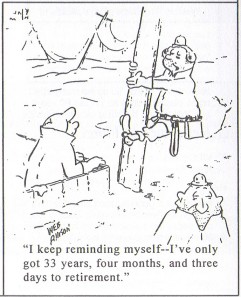
John C. Crawley of El Paso, Texas, shares
"I think old phone men will think this cartoon is funny."
Of course, John is a retiree from the phone company.
| Utility Finds Cedar Poles Best For Its
Diverse Climate
The service area of Washington Water Power (WWP) is a meteorologist's
nightmare. There's snow in the north, and dry but fertile plains in the
south. To the east are lush, moist mountains, and to the west are arid
foothills. In this diverse region any kind of weather is possible.
Because of the Spokane-based utility's broad range of climates, WWP
determined long ago that western red cedar was the best wood pole for its
26,000 square mile service area. The utility services about 256,000
customers with 40,000 transmission poles and 180,000 distribution poles.
More than 90 percent are western red cedar. The rest are larch.
"Cedar works very well for us," reports Rick Vermeers,
Assistant Operations Manager, who is responsible for the departments of
forestry and testing and treating. "We stretch from the Canadian
border to the Lewiston (Idaho) area, west to Othello and east into the
Silver Valley area of Kellogg and Wallace. We've used cedar since the
beginning. In 1903, we built a 100-mile, 60,000-volt Spokane-to-Burke line
with cedar poles, and the Devil's Gap West line, which still has original
poles in place today, went up in 1924."
He also says that the few larch poles the utility has were installed in
the 1960s and 70s, and many are already being replaced.
Many Poles From 1930s
Vermeers said WWP grew tremendously in the late 1930s, and many cedar
poles now in use date from that period. Cedar is used for transmission of
230 and 115 kV. Distribution poles carry 35, 24 and 13 kV. Transmission
poles are up to 100 feet, but these are not common. Most distribution
poles are 40-45 feet in Classes 3, 4 and 5.
"Our guys love the climbability of cedar", he reports.
"They also like it because it's clean, since we use butt-treated
poles only."
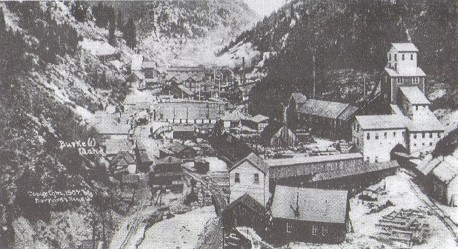
WWP's first high-voltage transmission line used cedar poles
to supply power to mining town Burke, Idaho.
Testing Program
Vermeers stated that the utility started a major testing and treating
program in 1988 and is slowly building to a 15 year inspection cycle.
"We're inspecting about 12,000 poles, using both company crews and
outside contractors. We replace about three percent and field stub about
11 percent."
Vermeers added that Washington Water Power's management also likes the
cedar poles. "It has a superior life cycle compared to other species
and it takes treatment well. Plus, there is a limited disposal problem.
Farmers use the butts for fence posts and the untreated upper portion for
firewood."
Western red cedar poles tolerate extreme weather and provide many other
advantages. When utility companies like WWP invest in cedar, they end up
reaping the benefits many years down the road.
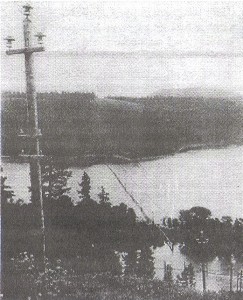
- - - and the Spokane to Burke line in Washington shows old
multi-part porcelain insulators. Both of these lines have historical
significance and are a testimony to the reliability and longevity of poles
and the insulators."
From the CEDAR POLE NEWS Western Red Cedar Association Vol. 6, No.1
Spring 1993 |
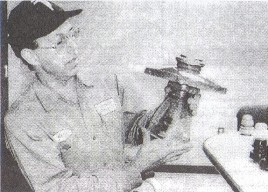
Familiar with the history of the poles and the insulators that
adorned them is Joe Maurath, Jr. of South Weymouth, Massachusetts. A collector,
a historian and researcher and editor of "Insulator By-Lines" that
appeared in Old Bottle Magazine from 1974 to 1981, Joe has more recently
been instrumental in helping to chronicle the history of the Hingham Municipal
Light Plant where he serves as an assistant technician. Assembling historical
facts and artifacts for the company's centennial celebration, Joe was a major
contributor to Hingham's" 100 Years of Community Service" publication.
Pictured below are workers at 176 Main Street in Hingham installing overhead
lines for the trolley systems in 1896. Note the wooden platform on the back of
the horse drawn wagon. I am sure those must be supervisors, not linemen, in the
suits and derby hats!
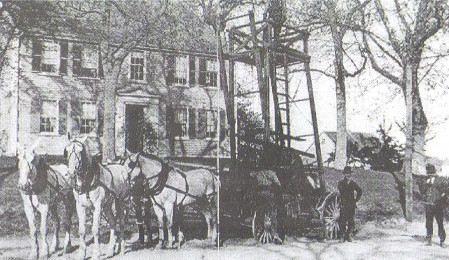
Joe also shared with Crown Jewels of the Wire readers his story of
forty years of collecting in a four part series during 1995. Another photo from
the Hingham centennial pamphlet showed linemen at work during 1970. I wonder if
these were the gentlemen Joe had help him procure many additions to his
collection during his teenage years?
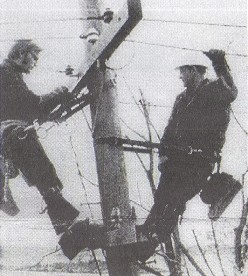
Rick Kelly of Salt Lake City, Utah brought a copy of the 1987
publication "75 Years of Reliable Service - Utah Power & Light
Company" to share at the national show last summer. He said to "guard
it with my life", and I have and it is now time to share some of the neat
photos included in the booklet.
Salt Lake City, still very much a muddy frontier town in 1891 was the fifth
city in the world to install central station lighting. Only New York, London,
San Francisco and Cleveland were ahead of little Salt Lake. Linemen working on
street lighting...
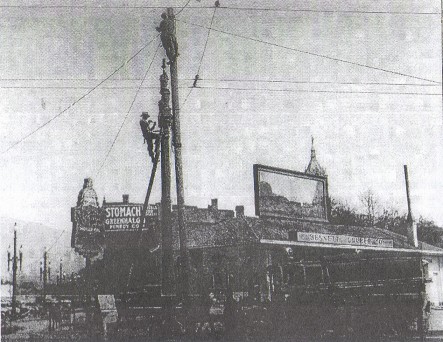
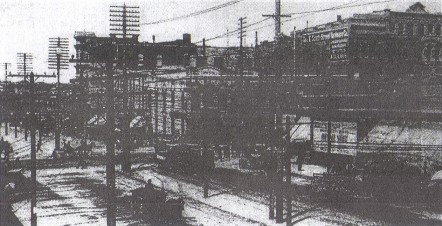
Wires and poles created a confusing jumble in downtown Salt Lake City in the
1890s. Because streets were so wide, poles had to be erected down both the sides
and the center of the streets. A variety of electric, trolley, and telephone
companies used their own poles and wires, which added to the confusion.
Strain towers on 13,000 foot Camp Bird Divide in western Colorado were
designed and built in 1894 by a Utah Power and Light predecessor to withstand
severe wind. Twelve ordinary wood pin-type insulators were mounted in a series
on a cross arm that was hinged to the pole structure. This arrangement of
insulators allowed each to withstand its share of the strain caused by high
winds, and the hinge arrangement of the cross arm provided for swaying during
wind storms.
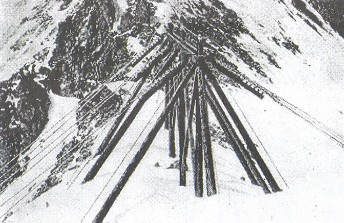
So, What is Wrong With This Picture?
 |
Ed Hunt of Apache Junction, Arizona sheds some light
on the scene ..."Connections Magazine" published in Trout
Creek, Montana, September/October 1994, shows ten linemen up the poles in
one picture. When's the last time anyone has seen such a sight? |
|
Construction of the Transcontinental Telegraph
Line???!!?? NAH!
More likely pole lineman's school.". |
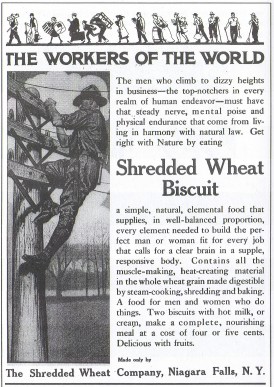
Medium Image (148 Kb)
Large Image (341 Kb)
I found this "pole and the man who loved it" a great addition to my
go-with file. This ad (even better in living color) came from The Countryside
Suburban Life, July 1917 issue. This was a recent purchase by your editor at
the Kane County Flea Market, St. Charles, Illinois. (See in color at http://www.insulators.com)
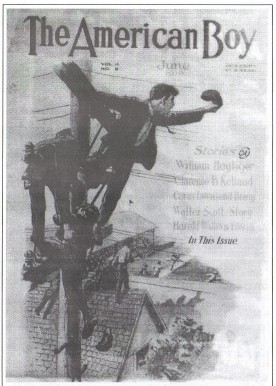
Medium Image (122 Kb)
Large Image (341 Kb)
Gene Condon, Moncks Corner, S.C. writes, "Good grief! Wonder how
many kids got dangerous inspiration from this cover on The American Boy,
June 1913?" The magazine was aimed at the wholesome and clean-living
American teenaged boys -- who were known to have used (as this cover
illustrates) a convenient utility pole to watch a game being played at the old
ball yard.
And, of course, the railroads had to maintain the signals along their
roadbeds. Larry Novak of Silver Spring, Maryland, found this neat cover
on the July/August 1995 issue of The Pennsy. "The original is
9" x 12" and is black and white except for the 'PENNSY' and the 'PRR'
symbol which are in red."
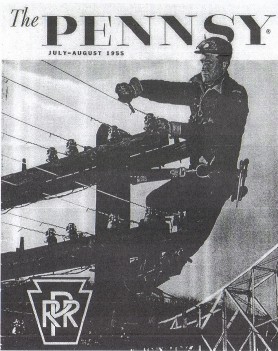
Medium Image (105 Kb)
Large Image (330 Kb)
And we move further south from Pennsylvania into the mountains of West
Virginia...
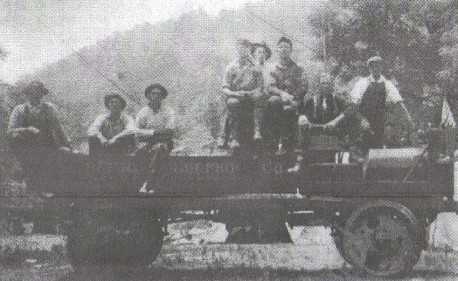
Jeff Hollis, Martinsburg, West Virginia, sent in this terrific old
photo. "I thought you might be interested in seeing a photo a friend of
mine unearthed in some old papers recently. The phone company name on the truck
is the Bluefield Telephone Co. (The original is clearer). Bluefield is in the
southernmost part of our state and it is strange that this shot would wind up
here.
"The Chesapeake and Ohio Railway runs through this part of the state and
if you look closely, you can see the track on a bridge to the rear of the
vehicle to the left of the wheel. Directly under the truck and at the extreme
right, you can see parts of a tent, indicating a workers camp!?! Note the
railroad wheels on the truck.
"A glass insulator collector would have to wonder how many cases of now
rare glass did this truck haul up and down the right of way while stringing
line. I would assume that, given the terrain of the Bluefield area, the
telephone company might use the railroad right-of-way to get their lines through
at a better cost. I also wonder how many nights did the phone line pioneers camp
at this spot watching the sun set behind the "Crown Jewels" they had
so recently installed? "You can read a lot into old photos. It's just a
shame it wasn't dated. Anyone in the Bluefield area with information?"

Collector Derick Lattig, Amarillo, Texas shares this local newspaper
ad aimed at cutting down on cable fraud. No that is not Derick
atop the pole!

Interesting selection of a photo showing the hoisting of a pole from the
Civilian Conservation Corps/National Archives. The photo is on the cover of In
Defense of Government -- The Fall and Rise of Public Trust by Jacob
Weisberg, 1996 Simon & Shuster, Inc. Margaret Cox, an employee of the
University of Texas Library in Austin, is always on the lookout for insulator
related items. She submitted the information for her brother, Ben Cox.

Face lift for power poles.
If you are driving near Priddis or Crossfield in southern Alberta, watch
for TransAlta utility poles sporting a triangular green sign with the letters
TWT and the recyling logo.
These aren't ordinary power poles. They have been recycled, part of a new
technology developed by TWT Technologies Inc., a joint venture of TransAlta
Enterprises and Worthing Industries Inc. Old poles are given a face lift by
shaving off the outer layer of wood. Both the shavings and the chemicals that
they are treated with are also recycled and reused.
"When you consider North American utilities purchase an estimated
eight million poles every year at a cost of about $2 billion, you can
appreciated that there are both environment and economic benefits,"
explains Adam Hedayat, manager of business development for TransAlta.
Hedayat says the recycling process can be repeated, tripling the life of
the poles and further reducing the pressure on forest. "We are also
ensuring that old, chemically treated poles aren't being used in the wrong
application or just being burned," says Hedayat.
TWT plans to market the technology world-wide and is already negotiating
with International Paper Co., the second largest manufacturer of utility poles
in the U.S.
From Current Living, published by TransAlta Utilities, Calgary,
Alberta January/February/March 1995, Sent in by Jim McLeod, Calgary,
Alberta, Canada
The Idaho Lineperson
A lineman is a person of stone
he or she works with a crew but sometimes alone
the work is tough and only for the bold
the work is very hot or it is very cold
it's only 3 times a year the weather is just right
in the spring or fall or on a great summer night
the times can be fun for the people are great
the work is heavy and sometimes we run late
It's not uncommon to be on a pole
with a wind so sharp it cuts to the soul
in the summer time with the heat so high
it's neat to crawl in a bucket and reach for the sky
with such extremes we become seasoned and old
this all adds to our character and soul
we work many hours to restore the light
for the power for the pump and heat that's just right
some days are long - 12 to 48 hours - with no rest
after a storm or an outage we will stay with the best
we work on holidays or even at night
if the power is out we are there to handle the plight
it is always clear to us on top
we must think before we move and then must stop
for the danger is here and very close
think again and again or take a terminal dose
we know the hazards of this great job
we earn money and rarely hob knob
we are people of pride and of some good sense
it is difficult to be strong and not ride the fence
all in all it is still to be said
the lineperson is strong and not full of lead
they will climb to the top for all to see
for the freedom is here - Oh God - how free
--- The Power Pup
(written by a lineman's wife, Idaho Power, submitted by Bud Thompson,
Boise, ID) |
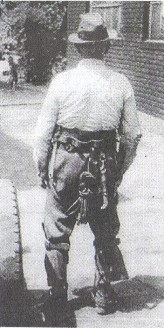 |
I wanted you to see the equipment on the reverse side of this old-timer that
was pictured at the beginning of the article. I am sure (during his days of
employment) that many a lineman might have turned their backs on the
all-inclusive nature of the profession today as noted in the above poem.
U.S. Pole & Supply Inc. 1990 Desk Calendar and Historal Journal
donated by Don Hostutler, Dover, Ohio provided information on the east
coast cedar poles and the final pole on the following page. Photos of "old
time lineman" found inside an electric department store room wall that was
being removed supplied by Chuck Knight, Logansport, IN.
This great piece of advertising was found on the website of John and Rick
Reinking of Woodinville, Washington. The Reinkings have done a tremendous
job of providing surfers on the net a virtual reality pole line that can be
walked to view a beautiful assortment of colorful insulators. Check it out at
http://www.halcyon.com/ reinking/
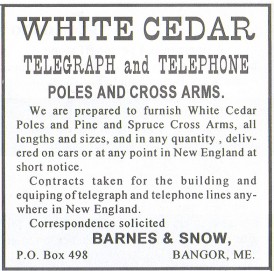
From Electrical World, c. 1883
And, the final pole of the first transcontinental telephone
line is put into service on the Nevada/Utah border (circa 1900).
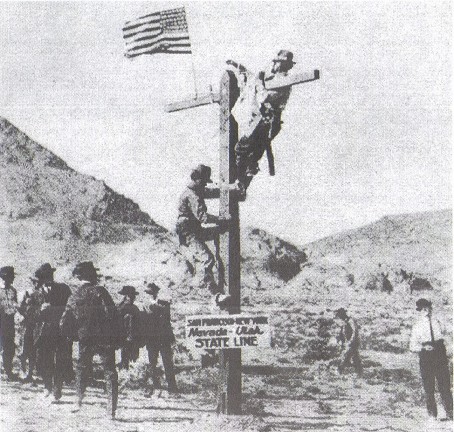
|
